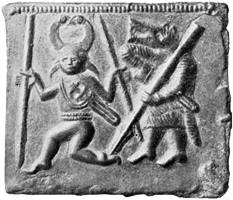
This page created 25 May 2014, and last modified: 3 November 2014 (Ammianus citations expanded)

In the western half of the empire, the third-most senior auxilia palatina unit listed under the Magister Peditum's infantry roster is the Petulantes seniores; it is assigned to his Italian command. Its shield pattern is shown in various manuscripts under the plain label Petulantes as below:

The pattern is relatively simple, featuring a yellow ground with a blue figure (white in W, B) that appears to be a debased version of the twin-headed zoomorphic motif that is extremely common in the Notitia (over a dozen examples), especially amongst auxilia palatina: the version borne by the Petulantes seniores lacks the "heads" (as do those of the two more senior auxilia palatina units in the west, the Cornuti seniores and the Brachiati seniores).
In addition to its numerous appearances in the Notitia, the twin-headed zoomorphic motif is known from a range of sources in northern Europe, such as on the ca. 6th century Torslunda bronze die from Sweden shown below:

In the history of Ammianus, "the" Petulantes are found brigaded with the Celtae (20.4.2, 20.4.20, 20.5.9, 21.3.2, 22.12.6, 31.10.4). In the Notitia, the Petulantes seniores are indeed followed by the Celtae seniores; whereas the Petulantes iuniores, listed under the command of the Magister Militum per Illyricum, do not appear to have any obvious partner (the Celtae iuniores are listed under the Comes Africae). Thus it would appear that "the" Petulantes and Celtae in Ammianus correspond to the Notitia's Petulantes seniores and Celtae seniores.
The name Petulantes means "headstrong, bold" (whence "petulant" in English).

Return to the Notitia alphabetical unit list page.
Return to my Notitia index page.